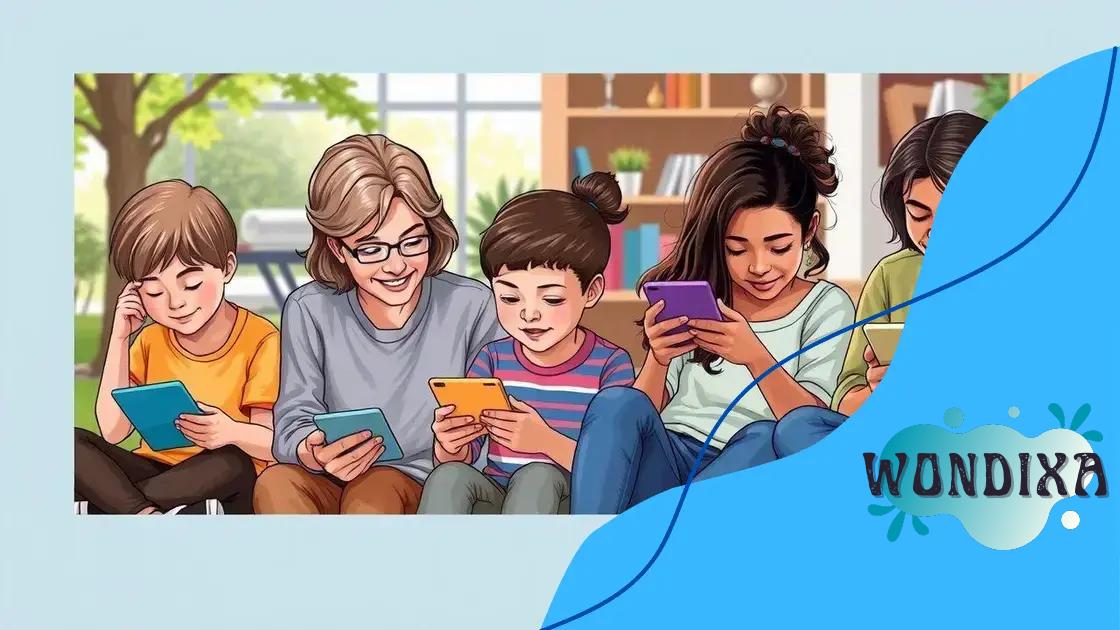Mobile apps supporting lifelong education: your path to growth

Mobile apps supporting lifelong education offer personalized, flexible, and engaging learning experiences through advanced technologies like AI and AR, while addressing challenges such as user motivation and technology accessibility.
Mobile apps supporting lifelong education are transforming how we engage in continuous learning. Have you ever thought about how these tools could fit into your busy life? Let’s explore their impact.
The rise of mobile apps in education
The rise of mobile apps in education has changed how individuals access learning resources. With smartphones and tablets at our fingertips, education is more accessible than ever.
Many learners appreciate the convenience and flexibility that these apps offer. They can study anytime and from anywhere, making education a fluid part of daily life.
Key Advantages of Educational Mobile Apps
These apps provide numerous benefits for learners of all ages:
- Personalized learning experiences.
- Interactive content that increases engagement.
- Access to a wide range of subjects.
- Real-time feedback and assessments.
Furthermore, the variety of applications means that there is something for everyone. Whether you are learning a new language or preparing for an exam, there are tailored resources to fit your needs.
Beyond the academic aspects, mobile apps also encourage collaboration. Learners can connect with peers and educators, enhancing their understanding through shared insights.
Popular Types of Educational Apps
Here are some common categories:
- Language learning apps like Duolingo.
- Math and science tools such as Khan Academy.
- Skill development platforms like Coursera.
- Interactive quiz and flashcard apps like Quizlet.
This diverse range empowers users to choose what aligns with their learning goals.
In conclusion, the rise of mobile apps in education illustrates a significant shift. As technology evolves, these tools create exciting opportunities for lifelong learners, making knowledge more accessible and engaging than ever.
Key features of effective educational apps
When exploring key features of effective educational apps, it’s essential to understand what makes them stand out. These features enhance the user experience and support learning in meaningful ways.
One of the main aspects is user-friendly design. A clean and intuitive interface helps learners navigate the app easily, making their journey smoother. Users can focus on learning rather than struggling with technology.
Essential Features to Look For
Several vital characteristics set top educational apps apart from the rest:
- Interactive content: Games, quizzes, and simulations engage users.
- Personalized learning: Tailored experiences based on user progress enhance retention.
- Offline access: Users can download content for learning on-the-go.
- Progress tracking: Features that monitor achievements keep motivation high.
Moreover, integration with social elements allows users to connect, share achievements, and collaborate. This enhances the learning experience by fostering a sense of community.
In addition to these features, effective educational apps often utilize gamification. This approach uses game-like elements to make learning fun and rewarding, encouraging users to stay engaged.
Technology Integration
Lastly, the integration of current technologies, such as artificial intelligence and Augmented Reality (AR), can revolutionize learning experiences. These advancements create immersive environments that aid understanding and retention.
Overall, choosing an app with these key features can significantly enhance the learning process. The right app can turn education into an enjoyable and interactive journey.
How mobile apps enhance lifelong learning

Mobile apps significantly enhance lifelong learning by providing accessible and flexible resources. These tools make it easier for people to learn new skills at their own pace, regardless of their busy schedules.
One way these apps support learning is through customized learning paths. Users can choose topics that interest them and follow content that suits their individual needs. This personal approach keeps motivation high and fosters a love for learning.
Interactive Features
Many mobile apps include interactive features that encourage engagement:
- Quizzes and challenges: These elements help reinforce knowledge and track progress.
- Discussion forums: Users can communicate with peers and mentors to foster collaboration.
- Gamification: Game-like elements make learning feel more fun and rewarding.
Additionally, mobile apps often provide a variety of formats for content delivery, including videos, articles, and podcasts. This diversity allows learners to choose what works best for them, catering to different learning styles.
Furthermore, the ability to access learning materials anytime and anywhere is a game changer. Users can utilize small pockets of time throughout their day to learn something new or reinforce what they’ve already studied.
Community and Feedback
Lastly, many mobile learning apps promote community building. Users can share their achievements and get feedback from others, which is vital for ongoing motivation and improvement. This sense of belonging can make a big difference in the learning experience.
In short, mobile apps are reshaping how we view lifelong learning, turning it into an engaging and adaptable journey that fits our modern lifestyles.
Challenges in using educational apps
Despite the benefits, there are various challenges in using educational apps that learners may face. Understanding these challenges can help users make informed decisions about their learning tools.
One common issue is the overwhelming variety of options. With so many apps available, it can be tough for learners to choose the right one. This choice overload may lead to frustration and indecision.
Technical Issues
Another challenge is related to technology itself:
- Connectivity problems: Many apps rely on internet access, which can be a barrier in some areas.
- Device compatibility: Not all apps work on every device, limiting accessibility for some users.
- Software updates: Frequent updates can disrupt learning, causing users to adapt to new interfaces or features.
Additionally, users may experience a lack of proper guidance when using these tools. Tutorials or customer support can vary significantly between apps. This inconsistency can leave learners confused, making it harder to get the most out of the app’s features.
Motivation and Distraction
Moreover, motivation is a significant hurdle. Users might find it challenging to stay motivated when learning on their own. The absence of routine and external accountability can lead to disengagement.
Distractions from other apps and notifications can pull users away from their studies. It takes discipline to focus exclusively on educational content in a world filled with entertainment options.
Overall, while educational apps can provide immense value, being aware of these challenges is essential. This awareness helps users navigate their learning journey more effectively and choose tools that best suit their needs.
Future trends in lifelong education apps
The future trends in lifelong education apps are exciting and aim to enhance learning for users of all ages. As technology evolves, these apps will adapt to meet the needs of modern learners.
One prominent trend is the integration of artificial intelligence. AI can personalize learning experiences by analyzing user data and suggesting content that fits individual needs. This tailored approach keeps users engaged and helps them learn more effectively.
Augmented and Virtual Reality
Another trend is the use of augmented reality (AR) and virtual reality (VR)
Furthermore, the rise of microlearning will influence how educational apps are designed. Short, focused lessons allow users to absorb information quickly. This method fits well into busy schedules, making learning accessible even in small doses. Apps will likely incorporate more social features to encourage collaboration. Users will be able to connect, share experiences, and even learn together in virtual study groups. This sense of community adds value to learning and fosters deeper relationships among users. Lastly, the future will see increased focus on lifelong learning by institutions and companies alike. As the job market evolves, the need for new skills will make lifelong education apps essential. Staying competitive will require continuous learning, and these apps will be at the forefront of this movement. In conclusion, mobile apps are transforming the landscape of lifelong education. As they evolve, these tools offer personalized learning experiences, engaging content, and flexibility that support learners of all ages. The integration of advanced technologies like AI and AR is set to create immersive and interactive educational experiences. While there are challenges, the benefits of using educational apps far outweigh the negatives. Embracing these tools will empower individuals to pursue their learning journeys effectively, making education an accessible and enjoyable part of life. Mobile apps provide flexible learning opportunities, allowing users to access a wide range of educational resources anytime and anywhere. Look for user-friendly design, interactive content, personalized learning paths, and community features that encourage collaboration. Challenges include overwhelming choices, technical issues like connectivity problems, and maintaining motivation while learning independently. Expect trends like increased use of AI for personalized experiences, integration of AR and VR for immersive learning, and a shift towards microlearning.
Community and Collaboration
FAQ – Frequently Asked Questions about Lifelong Education Apps
How do mobile apps support lifelong learning?
What are the key features to look for in educational apps?
What challenges do users face when using educational apps?
What future trends can we expect in lifelong education apps?





